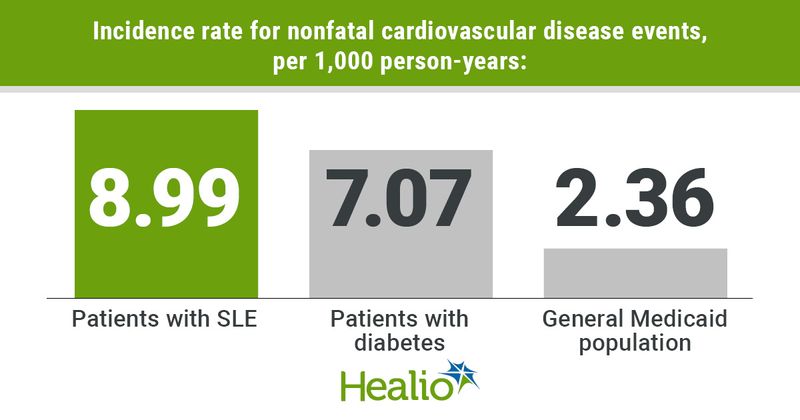Risk for nonfatal CVD events 27% higher in Medicaid patients with SLE vs. diabetes
Click Here to Manage Email Alerts
Patients with systemic lupus erythematosus demonstrated a 27% higher risk for nonfatal cardiovascular events compared with patients with diabetes, and twice the risk of the general population, according data published in Arthritis Care & Research.
“Cardiovascular disease (CVD) risk is elevated in systemic lupus erythematosus (SLE) and is the leading cause of death,” Medha Barbhaiya, MD, MPH, of the Hospital for Special Surgery and Weill Cornell Medical College, in New York, and colleagues wrote. “... Diabetes is also associated with premature atherosclerosis, conferring an approximately doubled CVD risk and increased risk of premature CVD death.”

“CVD risk stratification algorithms and aggressive prevention strategies, widely implemented for [diabetes], do not yet exist for SLE,” they added. “[Diabetes] is the prototype for aggressive CVD risk reduction efforts, but whether CVD risk is as elevated among SLE patients is unknown. As data quantifying the magnitude of CVD risk in SLE compared to more prevalent diseases using population-based data are lacking, clinicians may less vigorously seek and prevent CVD in SLE.”
To compare cardiovascular disease risk among patients with SLE and diabetes, as well as those in the general Medicaid population, Barbhaiya and colleagues studied data in the Medicaid Analytic eXtract (MAX). According to the researchers, MAX is an administrative database containing all billing claims for Medicaid from the 29 most populated U.S. states between Jan. 1, 2007, and Dec. 31, 2010. In all, they identified 40,212 patients with SLE, 80,424 with diabetes and 160,848 from the general population. Individuals were matched 1:2:4 based on age and sex.

The researchers used Cox regression models to calculate hazard ratios of nonfatal cardiovascular disease events that required hospitalization. These events included myocardial infarction, stroke, and combined myocardial infarction and stroke, all while accounting for the competing risk for death and adjusting to covariates. Further, Barbhaiya and colleagues compared risks in agestratified models.
According to the researchers, the incidence rate for nonfatal cardiovascular disease events was 8.99 per 1,000 personyears among patients with SLE, 7.07 for those with diabetes and 2.36 for the general Medicaid population. Nonfatal cardiovascular disease risk was higher among patients with SLE compared with diabetes (HR = 1.27; 95% CI, 1.151.4), due to excess risk at ages 18 to 39 years (HR = 2.22; 95% CI, 1.812.71). Patients with SLE also demonstrated higher a risk compared with the general Medicaid population (HR = 2.67; 95% CI, 2.382.99).
“In this large Medicaid cohort, despite lower prevalence of traditional CVD risk factors, SLE patients had higher non-fatal stroke but similar MI risks than [diabetes]; MI and stroke risks were over doubled in SLE patients aged [18 to 39] years compared to their [diabetes] counterparts,” Barbhaiya and colleagues wrote. “In [diabetes], excess CVD mortality is also particularly prominent in younger patients and substantial efforts are directed at CVD risk stratification and prevention; guidelines are available for statin initiation, antihypertensive treatment, and other lifestyle and pharmacologic interventions.”
“However, no such guidelines or CVD risk stratification tools exist for primary or secondary prevention in SLE patients,” they added. “Our data suggest that early and aggressive screening and better means of personalized CVD risk stratification and modification for SLE patients are needed.”
